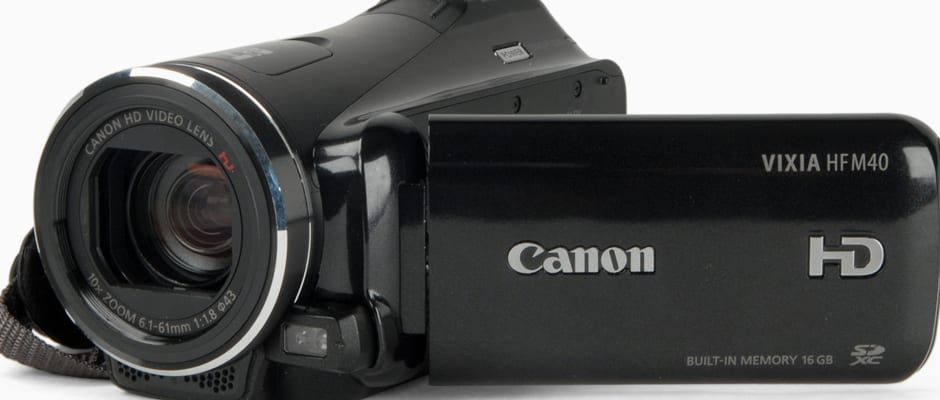Pros
Cons
Introduction
Design & Usability
{{section_header}}{{section.name}}{{/section_header}}
The HF M40 is a more compact camcorder than Canon’s hefty flagship, the HF G10.
We found that it fits comfortably in most hands, with a reasonably comfortable hand strap and contoured surfaces. If you’re using the accessory shoe, you might have trouble finding a spot to rest your pinkie, but that’s become virtually status quo for consumer camcorders these days.
For one-handed operation, the zoom toggle and record button rest comfortably within reach, but you won’t find any other buttons or features intended to be operated with the right hand. The rest of the camcorder’s controls are accessed via touch screen or nestled within the LCD cavity. We regret the absence of the excellent focus ring from Canon’s step-up model, but we don’t miss the awkward control dial.
The Canon HF M40 is relatively easy to use, though the sheer volume of options may intimidate first-time camcorder owners. A switch on the right allows users to activate a full Auto mode, which turns off nearly every other option in the camcorder. Some other auto modes are described in the Auto Mode section.
There are also two nifty little features that Canon has added in order to create a more accessible user experience: Video Snap and Story Creator. We describe both options in the Other Features section of this review. We’ve never found Video Snap to be particularly enticing, but we really like the Story Creator mode that Canon introduced this year.
{{photo_gallery "Front Photo", "Left Photo", "Left Open Photo", "Back Photo", "Right Photo", "Top Photo", "Bottom Photo", "Lens Photo", "Lens Photo 2", "3D Lens Photo", "Media Photo", "Easy Mode Photo", "Manual Controls Photo", "Zoom Photo", "Zoom Photo 2", "Ease of Use Photo", "Battery Photo", "LCD Photo 1", "LCD Photo 2", "EVF Photo 1", "EVF Photo 2", "Mic Photo", "Mic Photo 2", "Ports Photo 1", "Ports Photo 2", "Ports Photo 3", "Ports Photo 4", "Ports Photo 5", "Ports Photo 6", "Handling Photo 1", "Handling Photo 2", "Handling Photo 3", "Handling Photo 4", "Box Photo"}}
Features
{{section_header}}{{section.name}}{{/section_header}}
An embarrassment of riches
The Canon HF M40 offers the user tons of different options for a simpler automated experience. While we appreciate the many efforts Canon is making to ease the way for beginning users, there are times when we felt there were too many auto options. Essentially, you can shoot in full auto, program auto, scene mode, or Cinema Mode. Those can be combined with Video Snap or Story Creator. If that sounds confusing, we don’t blame you.
If you want a bit more control than Auto mode offers, you can keep the camcorder switched to Manual, then choose Scene Mode from the function menu. This gives you access to a handful of programmed scenarios—a list of options that Canon has expanded since last year. You’ll still be able to do a manual focus or tweak exposure compensation, but the HF M40 will lock you out of white balance, gain, and image effects. Cinema mode applies a digital filter to your footage, while giving you access to every control except for image effects. Programmed AE is the most versatile auto mode, giving you full access to all controls except for aperture and shutter speed. Every mode can be used in conjunction with Video Snap or Story Creator.
When it comes to automatic controls, the HF M40 performed quickly and accurately in most shooting scenarios. Auto exposure was sometimes very abrupt when moving from light to dark scenes, but we saw this on last year’s Canon models as well. AF/AE tracking returns this year and seems to work adequately, with the occasional loss of subject.
You’ll have to use the LCD touchscreen for everything, but we certainly don’t miss the clunky control dial from the HF G10. As with most touchscreen camcorders, we don’t like that your finger gets in the way when you’re making image adjustments, but touchscreens are becoming more and more pervasive, especially on entry-level and mid-range models. As for the extras, Canon provides optional features for face detection, backlight correction, auto slow shutter, and tele macro zoom.
Performance
{{section_header}}{{section.name}}{{/section_header}}
Decent all around, with very impressive low-light performance
The Canon Vixia HF M40 performed extremely well in our color tests, with very accurate colors and impressive saturation. Since this is a mid-range consumer camcorder, we expected to find unnaturally vivid colors (an aesthetic that many consumers enjoy). Instead, we found a nearly perfect amount of saturation, with colors that look very close to what we see in real life. Green hues were the most troublesome part of the spectrum for the M40. The HF M40 does not offer any color modes outside of its scene and Cinema mode selections, but it does offer the user some minor control over color depth, contrast, sharpness, and brightness. These controls are located in the Image Effects submenu within the main Function menu.
Quite frankly, we were blown away by the impressive performance of the Canon HF M40 in our low light video testing. Canon’s decision to lower the pixel count on its 2011 sensors turns out to be a wise one: sharpness is only slightly lowered, while low light performance took a huge leap forward.
The Canon HF M40 actually fared very well in our low light noise testing—likely another result of the sensor’s increased sensitivity. With consumer camcorders that typically increase gain automatically, noise is a common guest at the low light party. (Gain increases brightness, but also increases noise.) The HF M40 allows you to turn off gain through the manual AGC Limit control, but even with the gain set to auto, we found the footage had very little noise.
Canon is using the same Digic DV III processor from last year’s lineup, but has thrown a totally different sensor and lens combo into the mix for the Vixia HF M40. The new sensor did seem to take a bit away from sharpness, but the video looked excellent otherwise, making it hard to tell the difference between video recorded with the M40 and video recorded with the more expensive flagship model, the Canon HF G10.
Conclusion
{{section_header}}{{section.name}}{{/section_header}}
It turns out that Canon’s gamble to put all new sensors into the 2011 consumer lineup has really paid off.
The flagship HF G10 put up impressive numbers in low light performance—without much of a penalty to sharpness. For just $699.99 (MSRP), you can get virtually the same stellar performance in the Canon Vixia HF M40.
The HF M40 gets you a bit less in the way of manual controls, but there’s still plenty to offer here. There’s also a huge amount of auto modes to ease the way for beginners… perhaps too many auto modes. In our opinion, that leaves the HF M40 just out of reach for the raw beginner. For experienced users looking to get the most for their money, the HF M40 is a sure thing.
Science Introduction
{{section_header}}{{section.name}}{{/section_header}}
The Canon Vixia M40 (MSRP $599) is a solidly performing consumer camcorder that's made leaps-and-bounds improvements over Canon's 2010 line-up. Its performance was solid, and we were especially impressed by its low light performance.
Low Light Performance
{{section_header}}{{section.name}}{{/section_header}}
The low light performance blew us away.
Canon’s decision to lower the pixel count on its 2011 sensors turns out to be a wise one: sharpness is only slightly lowered, while low light performance took a huge leap forward. The M40 required just 5 lux of light in order to output 50 IRE: a performance that has only been rivaled by its step-up model, the HF G10.
Using the camcorder’s alternate frame rates, we were able to boost sensitivity even further, reaching 50 IRE with just 1-3 lux at 24p and 30p. We also looked at the M40’s sensitivity when zoomed all the way out to reach the camera’s widest aperture. At 60i, this resulted in a 50 IRE output at just 3 lux. Competing camcorders required 12-30 lux to match the Canon’s performance.
This all adds up to the best low light sensitivity we’ve seen from virtually any camcorder we’ve ever tested. If you plan to do a lot of shooting in dim conditions, these new Vixia camcorders are the perfect companion.
{{photo_gallery "Science Section 1 Images"}}
Video Sharpness & Stabilization
{{section_header}}{{section.name}}{{/section_header}}
Canon’s choice to decrease the pixel count on the 2011 sensors definitely impacted video sharpness, though not as drastically as we feared.
Horizontal sharpness of the HF M40 came in around 850 lw/ph, while vertical sharpness was 600 lw/ph.
Those are the same results we saw on the Canon HF G10 reviewed earlier this year. That represents only a minor decrease in sharpness from last year’s models—evidence, in our minds, that Canon’s decision was a wise one. The decrease in sharpness is only minor, but the improvement to low light performance is significant.
The regular OIS on the HF M40 worked decently, reducing 46% of the shake in our low shake test. In our high shake test, the regular OIS wasn’t as solid, reducing roughly 38% of the shake. Activating the Powered IS feature on the HF M40 increased results dramatically: 53% shake reduction in the low shake test and 67% reduction in our high shake test. The camcorder’s third stabilization option, active mode, was the worst of the three. It reduced shake by 21% in our low shake test and by 39% in our high shake test.
{{photo_gallery "Science Section 2 Images"}}
Meet the tester
Vice President of Editorial Management, Kaitlyn oversees the editorial departments of Reviewed.com’s various sites. She has been writing about technology since the turn of the century. Outside of her Reviewed.com home, Kaitlyn is also a theatre director and avid gamer.
Checking our work.
Our team is here to help you buy the best stuff and love what you own. Our writers, editors, and experts obsess over the products we cover to make sure you're confident and satisfied. Have a different opinion about something we recommend? Email us and we'll compare notes.
Shoot us an email

